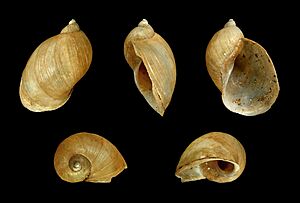Radix balthica facts for kids
Quick facts for kids Radix balthica |
|
|---|---|
 |
|
| Five views of a shell of Radix balthica | |
| Scientific classification | |
| Synonyms | |
|
The Radix balthica, also known as the wandering snail, is a type of freshwater snail. It's an aquatic mollusk that breathes air, just like you do! It belongs to a group called Lymnaeidae, which are often called pond snails.
Contents
About the Wandering Snail
Scientists use a system called taxonomy to group living things. This helps them understand how different species are related. For the Radix balthica snail, scientists have sometimes debated how to best classify it.
Where Do Wandering Snails Live?
You can find the wandering snail across a huge area. They live all over eastern Europe and stretch into western Siberia. They are also found in North Africa, Asia Minor, and Afghanistan.
These snails are common in many European countries and islands, including:
- Countries around the Baltic Sea
- Romania
- Germany
- The British Isles, including Great Britain and Ireland
- The Netherlands
- The Czech Republic
- Slovakia
Snail Genetics: Their DNA
Scientists have studied the complete mitochondrial genome of the Radix balthica snail. This is like a special instruction book found in their cells. It tells us a lot about how they are made.
The snail's mitochondrial DNA is about 13,993 nucleotides long. It contains 37 genes, which are like tiny blueprints for different parts of the snail. This information helps scientists learn more about the snail's biology.
Wandering Snail Biology
Radix balthica snails are very adaptable. They can live in many different water environments. You can find them in rivers, creeks, streams, and even still waters like ponds.
Habitat and Water Conditions
These snails are tough! They can handle different pH levels (how acidic or basic water is). They also tolerate various salt levels and temperatures. However, they prefer water that has a lot of calcium, which is called calcareous water.
Reproduction and Life Cycle
Like all pond snails in the Lymnaeidae family, Radix balthica are hermaphroditic. This means each snail has both male and female reproductive parts.
They lay their eggs in long, jelly-like strings. These strings are about 1 centimeter long. Snails attach them to hard surfaces like rocks, wood, or water plants. The baby snails hatch as tiny versions of their parents. There is no separate larval stage.
Mating and egg-laying usually start in March. Snails are about one year old when they begin to reproduce. A new generation of snails appears about once a year.
How Wandering Snails Breathe
Radix balthica snails breathe air using a lung. But they also get oxygen from the water through their skin! Their short, wide tentacles help them absorb more oxygen.
Their blood contains something called haemocyanin. This gives their head and foot a pale green color. Snails can also change how dense they are. They do this by moving muscles in their mantle (a part of their body). This allows them to quickly float to the surface or sink down in the water.
What Do Wandering Snails Eat?
These snails are like tiny cleaners! They mostly eat algae and bacterial biofilms. These are slimy layers that grow on hard surfaces. They also feed on detritus, which is dead plant and animal matter.
In some places, they mainly eat green algae and tiny living things called protozoans. In other areas, they might eat more detritus. Interestingly, Radix balthica snails do not eat healthy, living plants.
Snail Parasites
Sometimes, Radix balthica snails can have parasites. One type of parasite that can live inside them is a trematode called Aspidogaster limacoides.

